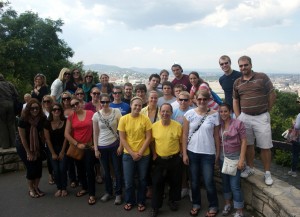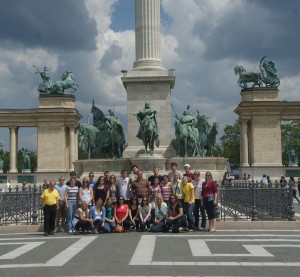The past few days have been spent at the border between the Roman and barbarian worlds–along the Danube. While it’s not blue, it is an enjoyable river for cruising, as we discovered yesterday on our relaxing journey from Vienna to the once twin cities of Buda and Pest, which are today, and have been for the past century, unified as Budapest. The hydrofoil trip took about 6 hours, which was about as fast as a bus–and because the roads were flooded, probably took less time!
Budapest has Roman ruins, not uncommon along the Danube, where the Romans had settlements to help fend off the barbarians; one of those settled areas takes its name proudly from the days it was a Roman possession–Romania. Budapest contents itself with more recent history–having been the capital of Hungary (until the 16th century, when, at the battle of Mohacs, Turkish armies conquered the city, and ruled Eastern Hungary until the previously mentioned Prince Eugene of Savoy led Austrian armies to free the city from the Turks over a century plus later, and made Hungary part of the Austrian Empire. After years of restlessness under Austrian rule, including a bloody revolution in 1848, Hungary became a kingdom (Austria an empire) under a common ruler, Franz Joseph. His wife, Elizabeth, better known as Cissy in Europe, was a strong supporter of Hungarian autonomy; hence, she’s got one of the nine bridges named after her. Budapest’s main historical remnants are from the Austrian period, though there’re renowned hot spring baths that the Turks made famous (Europeans hated to bathe in those days), and Roman ruins. Budapest’s other historical claim to fame (and its tie to my travels last summer) is that it was the westernmost point of the Mongol advance in 1241. It was before the gates of Buda that the Mongol armies paused, not because of European military prowess, but because of the death of the khan, which necessitated a return to the grasslands of Mongolia for the election of his successor. It was as far as the Mongols got, although for a century afterwards, brought a peace to the world between Beijing and Budapest, ended by the Black Death.
In other words, Budapest has helped define what happened to Europe.
Most of the Pest side is 19th century and later, a lot the monumental buildings due to the celebration of 1896–the millennium of Magyar rule (the Magyars also came from central Asia to the Hungarian plain); indeed, many of the sights we saw today came from the efforts to beautify the city in 1896 and create another “Paris of the East.” For example, we’re around the corner from Andrassy Street, named for the famous politician who was the first prime minister of Hungary, and at one time ambassador to Paris. The street has something like 114 villas created for the aristocracy; below it sits the oldest subway on the European continent, complete with old-fashioned cars.
At the end of Andrassy is the Heroes’ Square, which contains statues honoring the 9 chieftains who led their tribes to the Hungarian plain, including Arpad, who founded the Arpad dynasty, in 896, and his descendant, Stephan (St. Istvan), who converted the country to Catholicism (convert or die) in 1000. Flanking the square are the art museums, one built in the classical style, the other with a mosaic that resembles an Eastern icon. Behind the park are public baths and a major park that includes a recreated castle, a bathhouse that also looks like a castle (named for another prominent family, Szecheny), an outdoor skating rink, a zoo, and a fine old restaurant that, when the guide was naming famous people who had eaten there, I had her include the famous Mr. and Mrs. Hoyt (who ate there in 2002). The most impressive building exemplifying the majesty of the Kingdom of Hungary (especially after 1867 and before the treaty of Trianon carved Hungary by recreating states such as Czechoslovakia that had not been states since the 13th century, or the Kingdom of Slovenes, Croats, etc. that had never really been independent, at least not as such, and later became Yugoslavia) was the Parliament. Opened in 1902 for a bicameral legislature of the larger Hungary, the design won a contest. The designer, with a British background, made it resemble Parliament in Great Britain. It has 365 windows, and more resembles a palace than many of the palaces we’ve seen. My favorite touch was the numbered racks for cigars on benches outside the main hall; if you needed to go back in, you could leave your cigar there for later consideration. The dome of the Parliament also houses the crown jewels, including the reputed crown of St. Stephan. If you collect stamps (or know the coat of arms of Hungary), you’ll know that crown.
One of the other sights in the government building area is the buildings that still have the bullet holes from the 1956 uprising against the Soviets. This morning, an elderly gentleman approached me at breakfast and asked where I was from. He said he was now living in Vancouver, but in 1956 had been one of the freedom fighters against the Russians as a student. Nice sense of history there, although it took almost 35 more years for the goals of the students to be realized.
The Buda side contains hills–and hence the castle and the old walled city are located there. The area was pretty well destroyed in World War II when the Germans dug in there (the Hungarians sided with Germany to regain the larger Hungarian lands they had lost, including the areas in Rumania where I’m going to be) and the siege destroyed about 60 percent of the city. Our guide apologized that the recreated palace did not look like a palace inside, and had no royal trappings, but once upon a time the King of Hungary waxed fat off tolls levied on traffic on the Danube. There was a chain across the river that stopped ships and was not opened till they’d paid up–and you thought Robber Barons applied to the castles on the Rhine. Consequently, at one time the castle ranked among Europe’s finest, and it looked splendid all lit up last night, when some of us took a boat trip along the Danube. Much of the castle town has been rebuilt in 18th century style, and there are some fine museums up there in addition to those in the Palace; I’ve visited the military museum (displays mostly in Magyar, a Turko-Finnish language that has few relatives in Europe other than Estonian and Finnish; a quick trip, in other words) that taught me a lot about the 1848 revolution against Hapsburg rule that made a hero of Louis Kossuth, who as I recall wound up in America, for example. We had lunch on the Buda hill in a building with a courtyard, and took lots of pictures inside the St. Mattias church (rebuilt a number of times since 1241 as war, fire, and changing fashions dictated), with a ceramic roof that is peculiar to Hungary. We took lots of pictures as well from the Fisherman’s bastion, a Disney-like assortment of towers that overlooks the river and the section of the city that had once been the fishermen’s area. It, too, was part of the celebration of 1896.
On the Pest side, we spent some time in a market building that had souvenirs and reasonably priced ethnic foods including paprika and pancakes. The guide took us to an Orthodox Church (which in the 1990s switched from the Greek patriarchate to the Russian one), in effect reminding us once again of the differences in religion between East and West. Her walk down the street blocked off for pedestrian shopping was an architectural tour de force. One highlight was a palace of commerce–an art nouveau shopping center with a vaulted roof to keep customers dry, and carved windows and awnings to demonstrate that the burghers could have palaces, too. In St. Stephan’s basilica (a basilica, I learned, is a church blessed by the pope), the largest Church in Hungary–conceived in 1850s, opened finally after the turn of the century–we saw the preserved right hand of St. Stephen for 200 florint (the money is named for a Florentine banker brought here long ago to establish a currency). I returned to the church tonight for an organ concert.
I think my conclusion is still that Hungary is the beginnings of Eastern Europe. After all, transportation costs less than a dollar and the cars do not try to run you over.
Tomorrow is our first full free day on the trip. I realized I’ve been here in Budapest five times, and seen most of the museums I’d want to see; hence, I’m going to Estergom, the religious capital of Hungary (and for a time, when the Turks ruled Budapest, the political capital as well), and if time permits, on to Visygorod, the home of a huge castle built by one of the Hungarian Kings. We leave tomorrow night for Bucharest, a 15-hour train ride, which gives some idea of how large Eastern Europe–and by extension, the Kingdom of Hungary–is and was.



